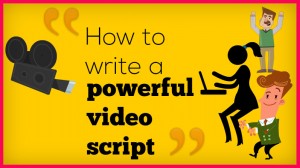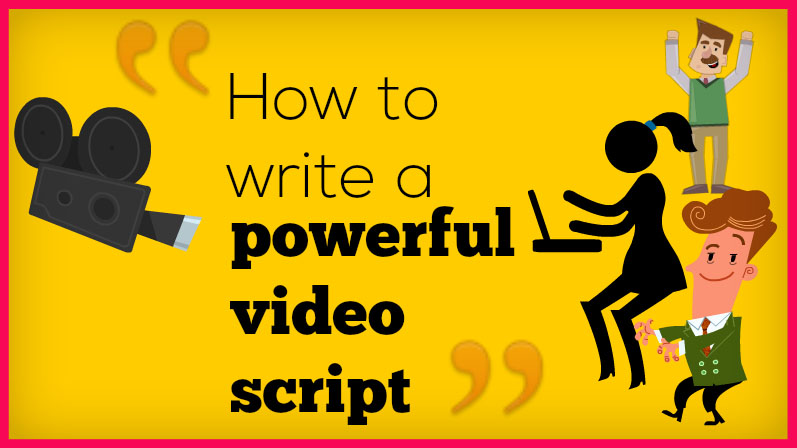A video is a powerful tool when created from the ground up in the right way.
It has the power to tell an engaging story about your business with-in 60-90seconds. But before you even think about the engaging animation ideas and images, you need to get the first and most important element into place first.
And that is to develop a killer script. A well-written, engaging script is THE foundation for a results getting successful explainer video. Without the right foundation, the rest of the creation process will be far less effective.
HOW TO MAKE SURE YOUR VIDEO IS KILLER
So what can you do to make sure your video is killer engaging and not just a nap inducing drag?
 It all starts with proper preparation. I know that does not sound exciting but it is essential.
It all starts with proper preparation. I know that does not sound exciting but it is essential.
The proper preparation means you need to:
- know your audience (who they are – how they speak – what their fears, hopes and desires are)
- know the message you want to convey
- know what call-to-action you want them to make after watching your video
7 TIPS TO HELP YOU WRITE A BETTER SCRIPT
1. Keep the script short.
The length of your script will depend on your audience and what message you want to convey.
A captive audience in an auditorium endures about six to eight minutes before beginning to drift.
An internet surfer popping by your website needs to be gripped in the first 7 seconds but then many may start to check out after two to four minutes (depending on how compelling your message is and whether or not you have hit on their fears, hopes and desires using their language and tied it into your product or offer).
2. Put your message in the first 30 seconds.
Reduce the message of your entire video into one sentence and get that sentence somewhere in the first 30 seconds of the script. This tells the audience what to pay attention to in the video and why it’s important to watch to the end.
3. Speak directly to the audience.
The easiest way to speak to an audience is to speak to them in the language they already think in. And address their WIIFM (I’ll explain this shortly).
Many marketers suggest to use words like “you” and “your” – as your audience will instantly know this is relevant to them – but this will highly depend on the style of script you create.
The most important aspect is to speak in the language your audience already uses and thinks in; and address the things that are already important to them and that they already care deeply about.
Whilst you may be proud of your achievements, your brand and all the features your service or product has; what your audience really only cares about is WIIFM (What’s In It For Me).
 The quickest and easiest way to address your audiences WIIFM is to directly speak about or highlight the problem they are experiencing right now, using the language they think in (instead of your own fancy industry jargon). If you can express your audiences problem better than they can, and in the language that they already think in; their attention is automatically grabbed; and strangely a level of trust is automatically formed, as you’ve demonstrated that you understand them, their WIIFM, and what they care deeply about.
The quickest and easiest way to address your audiences WIIFM is to directly speak about or highlight the problem they are experiencing right now, using the language they think in (instead of your own fancy industry jargon). If you can express your audiences problem better than they can, and in the language that they already think in; their attention is automatically grabbed; and strangely a level of trust is automatically formed, as you’ve demonstrated that you understand them, their WIIFM, and what they care deeply about.
Now this WIIFM or problem could be many things, such as not getting enough sales, losing customers to the competition, not able to get a date, suffering from acne, pain and difficulty in walking… whatever your audience is experiencing that they want solving passionately is a great way to grab attention, address your audiences WIIFM and make your script instantly engaging. Now obviously it is pointless highlighting problems your service will not help solve but knowing your audience well and understanding the language they think in is the master key here (and in any marketing or relationship building material for that matter).
You can also weave into the script the positive outcomes that they would ideally want to be experiencing such as an improved bottom line, increased sales, able to get more time off for more holidays or vacations with the family, being in a loving relationship with your soul mate, winning a marathon, getting a promotion, being respected and highly valued or even saving them time and money. Whatever the benefit your audience would ideally want to be experiencing once their problem is solved is the penultimate of their WIIFM.
Draw on their hopes, fears and desires by taking them from their current problem situation to where they would ideally want to be and how they would ideally want to experiencing life. Then simply introduce your product or service as the proven solution to get them from where they are to where they want to be faster and easier (but only if thats true, that is).
Don’t talk down to your audience or over their heads with technical consultant like language. Make friends with them, speak to them as friends, add value to their lives – this inevitably uncovers a level of know, like and trust. People only do business with people they know like and trust.
Then finally ask for the action you want them to take which will get the ball rolling for them.
4. Find the right tone.
Have a mental picture of your customer in mind first – create an avatar or character that is an amalgam of all the common characteristics of your ideal customer. Give this character, this avatar a name – so it focuses your mind and makes who you are talking to more tangible and real – and then allow this to direct the tone of your script and video.
Write a one sentence summary describing why you are making the video and what you want the viewer to do at the end of it. This will help clarify the tone and style for your finished video. You may decide you want a talking head in an office, a brief classroom style presentation, a light hearted romp, a bold outdoorsy documentary, a dynamic clean and clear action packed animation with lots of text, a fun cartoon presentation that rekindles a childhood remembered relaxed state of mind or a bright and colourful animated review in an honest and transparent way.
 If you have story-driven characters, imagine real people as mental place-holders. It’s much easier to write realistic dialogue if you are writing for someone whose habits and mannerisms you know well. The tone you choose for your video will then drive your choice of setting, narrator, cast, tempo, pace and type of dialogue for the script.
If you have story-driven characters, imagine real people as mental place-holders. It’s much easier to write realistic dialogue if you are writing for someone whose habits and mannerisms you know well. The tone you choose for your video will then drive your choice of setting, narrator, cast, tempo, pace and type of dialogue for the script.
5. Tell a story.
Most explainer video scripts present a problem (Bob is tired), introduce a solution (Bob drinks organic, sugar-free, calorie-free, nutrition-free energy drink), explain how it works (OrganiBrew is all natural…blah blah blah), and drive viewers to action (buy OrganiBrew at your local store).
Dry facts, statistics and definitions can appear lifeless unless you craft them and present them in an engaging and relevant way – so unless they are essential in the process of drawing the line from your audiences fears, hopes and desires to the results they want and how you can get them there faster and easier – it can be a good thing to put them to one side. Instead, use the power of the screen to show your audience actual people your company has helped, or the benefits your services have delivered to customers. Human beings naturally create stories about themselves to help them define who they are. The better you tell stories – the more likely your viewers are going to understand what your company is offering and what it can do for them.
6. Use humour wisely.
Humour is a great tool for story-telling so long as the humour supports your message. Make sure your attempts at humour fit seamlessly within the story you’re telling, and keep in mind that misplaced or poorly timed humour can be distracting and off putting to potential customers.
*Tip: You can try to include written humour in your script, but sometimes it’s more effective to introduce humour as part of the on-screen animation.
7. Pace yourself.
Keep dialogue to between 125 and 150 words for a 60 second video; but if you need to address more points a 90 second video will be based on a 225 worded script. While you might be able to speak 200 or more words per minute on your own, keep in mind that the voiceover needs time to breathe and to allow viewers to absorb and understand what you’re saying (this is even more true when the content is particularly dense or of a technical nature). Machine gun fire dialogue quickly overwhelms and confuses viewers, causing abandonment, decreases comprehension and dramatically reduces conversion rates. “A confused mind makes no decision.”
When producing an explainer video, don’t skimp on the script. Take the time necessary to do it right.
Get feedback from friends and co-workers, and make sure it’s engaging and easy to understand.
FEEDBACK IS IMPORTANT – IT HELPS ME TO IMPROVE AND GIVE YOU BETTER VALUE
If you have any questions or comments please post them below.







